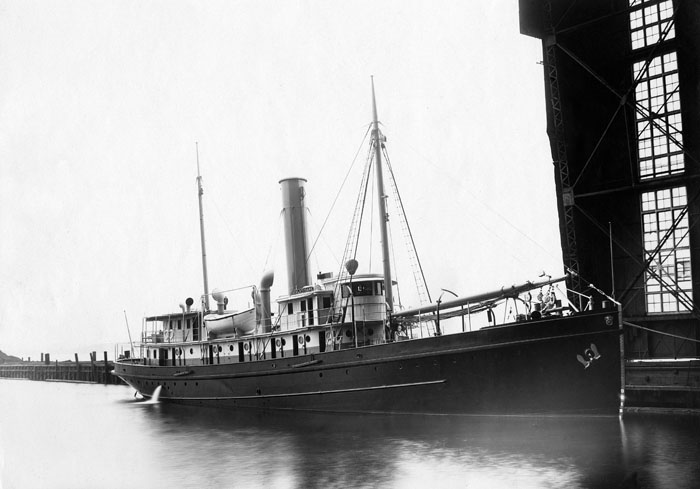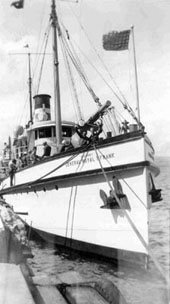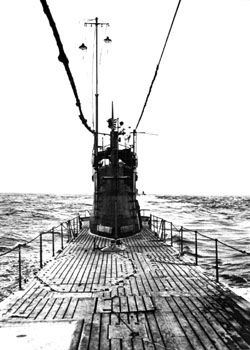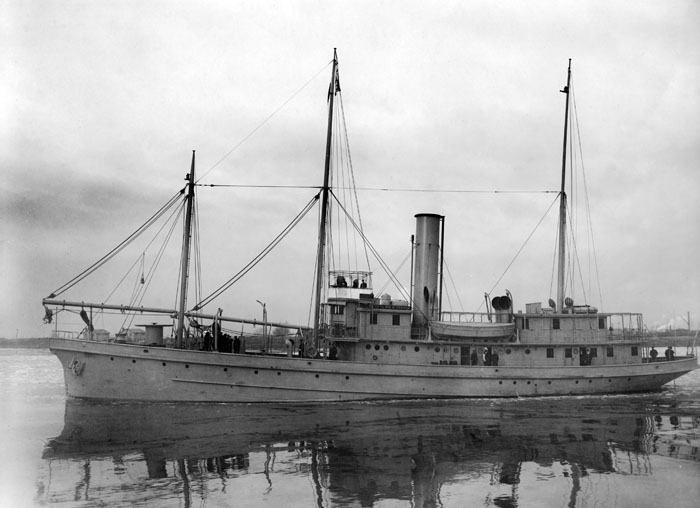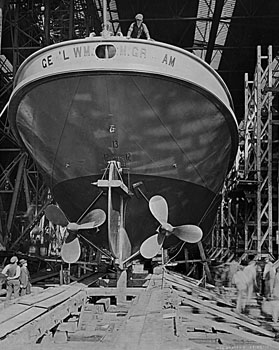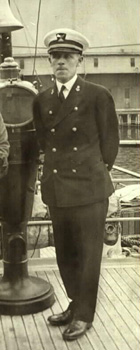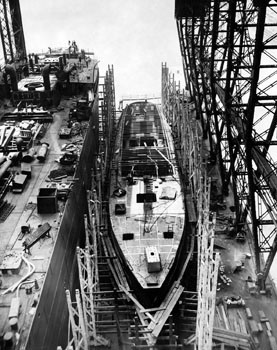UNITED STATES HARBOR DEFENCES - USCG CABLE SHIP PEQUOT
SISTER SHIPS
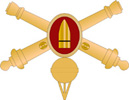 |
Construction Photos of the Mills, Frank, Schofield, and Graham - Independence Seaport Museum Archives, New York Shipbuilding records www.phillyseaport.org/library Construction Photos of the Mills II and Frank II - Marietta Manufacturing Company Records (#742), Special Collections Department, J. Y. Joyner Library, East Carolina University, Greenville, North Carolina, USA. http://digital.lib.ecu.edu/special/ead/findingaids/0742/ |
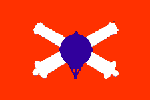 |
This page provides more detail related to the U.S. Coast Guard Cable ship Pequot during World War II. It describes the design and construction of several sisterships to the Pequot - a ship that undertook the vital harbor defense cable-laying program along the eastern seaboard of the USA. Our main page for the USCG Pequot provides extra details about the ship, its crew, its purpose as well as links to our other Pequot pages. Research and design by by Chip Calamaio and Richard Walding.
 |
|
The US Coast Guard Pequot (previously The General Samuel M. Mills). During WWII this cable ship laid top secret Indicator Loop cables to protect harbors from German U-boats. Her mission ranged from the ports of Virginia up to Argentia, Newfoundland. (Calamaio family). |
MEET THE PEQUOT'S SISTER SHIPS
"Sister Ships" are a group of ships of virtually identical design to another ship. For instance, the U.S. warships USS Iowa, USS New Jersey, USS Missouri, and USS Wisconsin, are all sister ships, each being an Iowa-class battleship. The main purpose is to achieve economies of scale for contracting and construction, similar to an automobile assembly line, only on a much larger scale. In the case of the USCG Pequot, originally built as the Army mine planter the General Samuel M. Mills, her sister ships included the General Royal T. Frank, the General John M. Schofield, the General E.O.S. Ord, and later, with some modification, the General William M. Graham. For our purposes we are broadening the Sister Ship definition to include the 1942 Camanche class Army Mine planters who were not only the namesakes of the original Mills and the Frank built in 1908-09, but also to acknowledge their parallel mission of laying not only sea mines but underwater cable used for a variety of purposes. We believe that many of the WWII Indicator Loop cables installed outside of the Pequot's service area were laid by these Camanche class mine layers along the Southern Atlantic and Pacific coasts. This concept is reinforced by the fact that when the Pequot was retired from service after WWII, the Camanche Class mine layer, Trapper (ACM-9) was modified to become a full time cable ship as Pequot's replacement, the USCG Yamacraw (WARC-333).
For stories about the crew and history of the USCG Pequot please go to the USCG Pequot main page.To see plans and photos of General Samuel M. Mills under construction in 1908-09 go to the Pequot Plans page
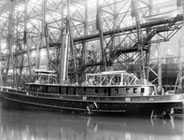 |
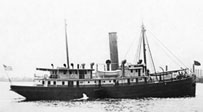 |
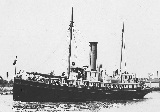 |
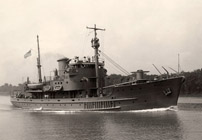 |
 |
| Gen. John M Schofield | Gen. Royal T Frank | The Gen. E.O.C Ord | 2nd Gen Sam M. Mills | 2nd Gen. Royal T Frank |
| Click on the image above to go to the ship. | ||||
 |
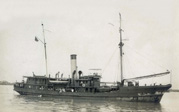 |
 |
|
| Gen. Wm M Graham | The Joseph Henry (still afloat) | ||
| Click image above to go to the ship. | |||
General John M Schofield
 |
|
1. The Army Mine Planter General John M. Schofield, June 4th 1910 (US Naval Institute) |
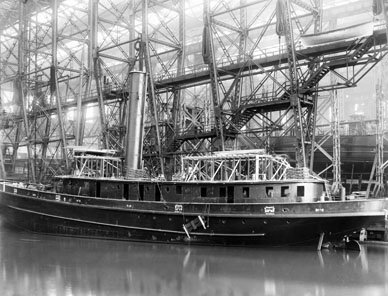 |
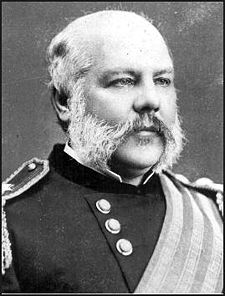 |
| 2. The General John M Schofield under construction in 1909. | 3. John McAllister Schofield 28th U.S. Secretary of War. Library of Congress, Civil War Photographs Collection). |
The General John M Schofield
was built under contract #76 with the New York Shipbuilding Company in shipway L
next to the General Samuel M Mills with her keel also laid on October
12th, 1908. The ship was launched on February 20th 1909 and after outfitting
and sea trials was turned over to the US Army for mine planting duty on June 2nd
1909. After 38 years at sea she was scrapped after World War II in 1947.
The ship was named to honor General John McAllister Schofield who was the
28th U. S. Secretary of War and Commanding General of the United States Army
1888-95.
General Royal T. Frank
The General Royal T. Frank was constructed under contract
#77 in shipway L at the New York Shipbuilding Company. Her keel was laid on
October 20th 1908. The ship was launched on March 15th 1909 and once outfitted,
and put through her paces at sea, was delivered to US Army Mine Planting Service
on June 8th 1909. The ship was named to honor the U. S. Army Brigadier
General Royal Thaxter Frank who fought during the Spanish-American War and
during the Civil War at the Battle of Fredericksburg.
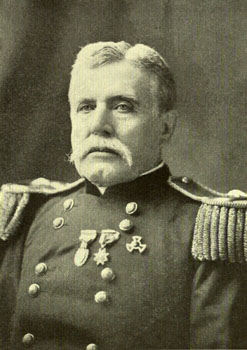 |
3. General
Royal T. Frank (Special Collections, US Military Academy Library, West Point) |
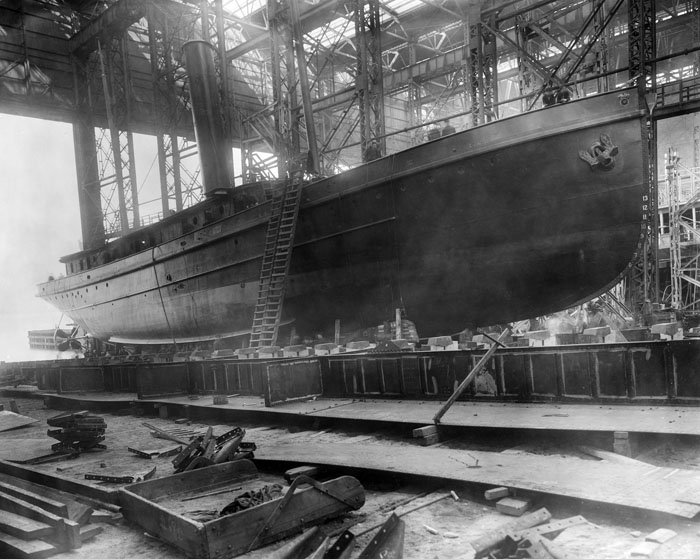 |
4. The
General Royal T. Frank under construction in Shipway L. Click to
Enlarge |
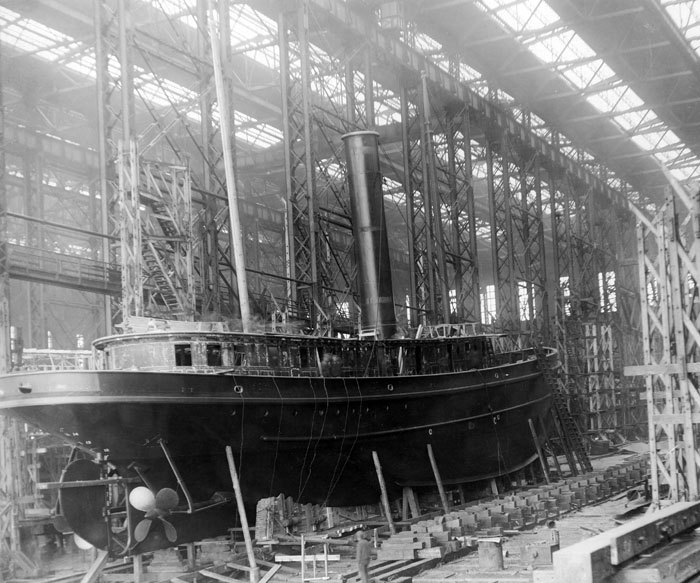 |
5. Prior to
launching we see the Frank on wooden ways and supported with bracing.
|
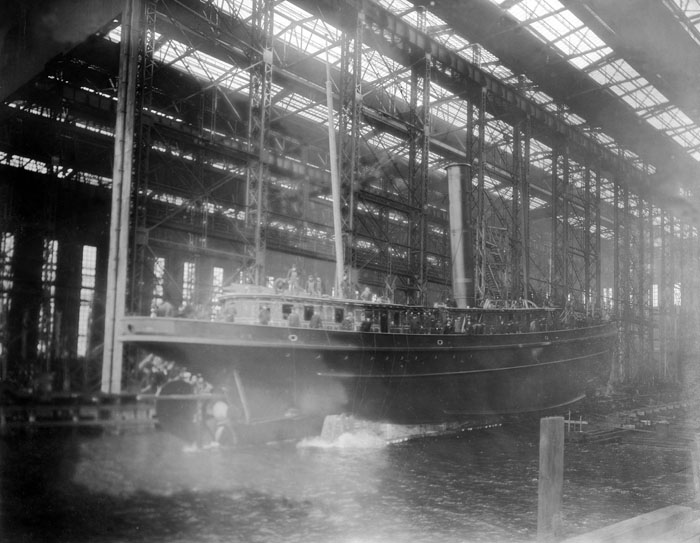 |
6. More
than 30 men are on deck with ropes and cables along the gunwale as the
shipway is flooded and the Frank slides off the ways and is launched.
Click To Enlarge |
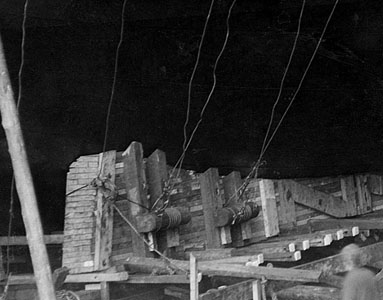 |
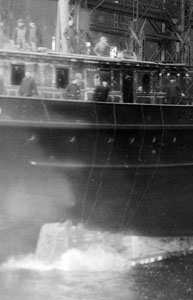 |
7a,b. We see
that as the ship becomes buoyant the wooden ways holding the hull in
position are pulled free by the men on deck which enables the Frank to
slide out of the shipway. |
|
 |
|
8. The Frank on the Delaware River immediately after launching from Shipway L.The upper deck cabins have yet to be constructed and the mast rigging completed. |
By the late 1930s the ship was serving in the Hawaiian Islands as an
inter-island transport to ferry Army troops between bases on the different
islands. She also often took soldiers and their families from Honolulu and other
islands to Hilo on the Big Island for recreational leave.
 |
|
10. The
General Royal T. Frank US Army Field Artillery Journal, December 1942 |
 |
|
|
11a. With the Union Jack snapping at the bow we see the Frank in 1937 docked at one of the Hawaiian Islands working as an inter-island transport. Click to enlarge. (Courtesy Randy Biddle, Windship Studios & Ramon Jackson) |
11b. The US Army Transport the General Royal T. Frank
circa 1935 steaming out of Honolulu Harbor on her way to another military
base in the Hawaiian Islands. Note the single large boom arm for cargo work
and the absence of a radio directional finding (RDF) radio antenna atop
the wheelhouse like the Pequot had by the 1920s. (US Army Museum of Hawai'i) |
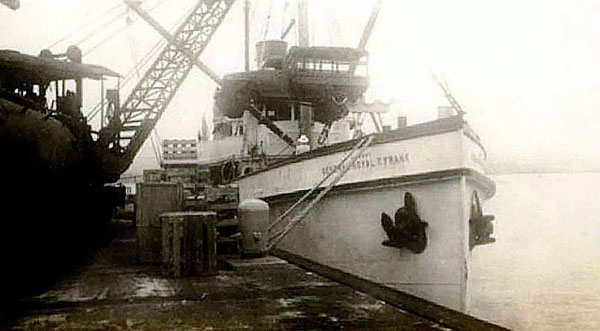 |
|
12. An Army transport truck is being lowered by a dockside crane onto the Frank's fo'castle deck for delivery to one of the Army bases on another island. On the pier we can also see wooden crates of cargo. In this image it appears that the Frank still had at least two forward booms operational off the forward mast. (Courtesy of Ramon Jackson) |
|
|
|
|
13a, b. The Japanese Submarine I-171 which sank
the General Royal T. Frank. In these rare views of this KD6 class sub
we see the ship underway and the view forward from the conning tower. This
boat participated in "Operation K," the Imperial Japanese Navy's
unsuccessful second attack on Pearl Harbor on March 4th 1942, it then
served on the first supply runs to Guadalcanal which sapped the strength and
morale of the Japanese submarine force. |
|
By 1944 the I-171 was assigned to Japanese Submarine Squadron 3 and based at Rabaul to resupply Japanese forces fighting American troops on Bougainville Island. While making a run between Rabaul and Buka on January 31st 1944 with her decks loaded with cargo in rubber containers, the American destroyers USS Hudson (DD-475) and the USS Guest (DD-472) picked up the I-171 on radar 15 miles from Green Island. Seeing the destroyers approaching at flank speed the sub made a crash dive but the destroyers quickly picked up the ship on sonar. After several depth charge attack runs the I-171 was sunk with all hands.
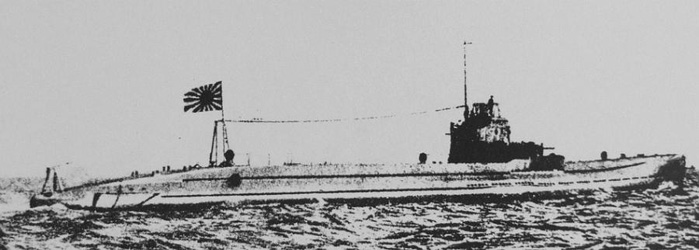 |
|
13c. Japanese Submarine I-171 with a large rising sun flag flying aft. (photoship.co.uk) |
On the afternoon of January 26th 1942 after finishing basic training at Schofield Barracks on Oahu 26 newly trained Army draftees had their photo taken by soldier Shigeru Ushijima before being split up and shipping out for duty assignments to different Army bases on the Hawaiian Islands. Ushijima gave the film from his camera to an acquaintance who took it to the Big Island for him to be processed. In less than 48 hours his camera would be on the bottom of the Pacific Ocean and 17 of those men would be dead.
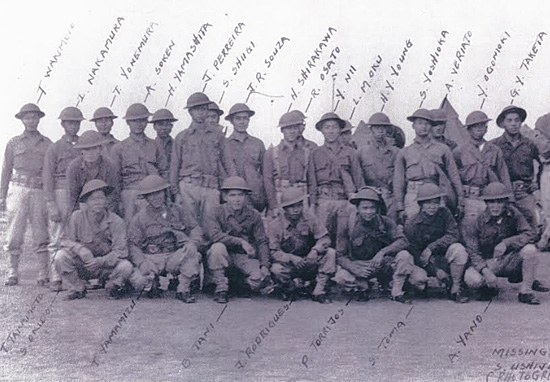 |
| 14. Shigeru Ushijima's "Torpedo Gang" photo taken at Schofield Barracks on January 26th 1942 |
On Tuesday January 27th the men boarded the General Frank in Honolulu and the ship set off for Maui under the command of Alex F. Sczymanski, a Master Merchant Marine Captian under the US Army Transport Service. First the ship traveled to Kahului and dropped off some of the troops on Maui to serve with A Company of the 299th National Guard garrison before setting off on the foggy and rainy morning of January 28th for the Big Island and Hilo.
According to accounts from survivors, one torpedo missed the Frank entirely, another made a glancing blow but did not explode. Sczymanski realized they were under attack and quickly started a zig zag pattern and the escort destroyer began dropping depth charges but within a matter of minutes a third torpedo made a direct hit on the Frank sending her quickly to the bottom. In Michael Slackman's "Target Pearl Harbor" he describes how "The Ship's radio operator Private Victor Rabinowitz, was trapped by a mast cable which fell across his leg. As the ship sank he was dragged down, but at last the cable was loosened and he bobbed to the surface. Chief Engineer Francis Wilson also had a narrow escape. He was pinned between a beam and an automobile being carried as cargo. Like Rabinowitz, he manage to free himself after the ship went under." None of the Army recruits or ship's crew who were below decks when the torpedo detonated survived. Those who did spent more than 2 hours in the water clinging to debris or hanging onto the side of the ammunition barge before being rescued and brought to Hana on Maui. Covered in oil, they were taken to a gymnasium where they were cleaned off with gasoline and issued new clothing. Injuries were treated at the Kaeleku Plantation Company clinic. Captain Sczymanski went down with his ship.
 |
|
15. The KD6 class submarine I-73 in Ariake Bay on the Southern tip of Japan, April 24th 1939. This sister ship to the I-171 was sunk by a US submarine early in WWII through radio intercepts and decryption. (Courtesy of Mitch Williamson) |
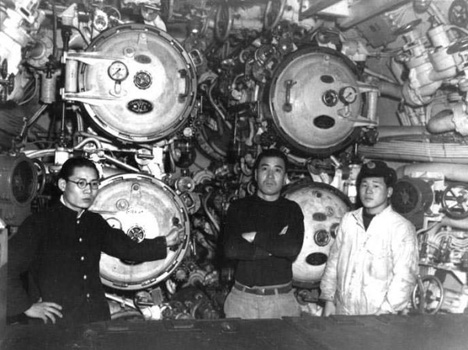 |
|
16. The forward torpedo room of a Japanese Kaidai Vla
submarine. (U.S. Marine Corps Photo Taken in Sasebo, Japan, January 28th 1946). |
As of the spring of 2011 according to the Japanese American World War II veteran's Hanashi Oral History Program of the Go For Broke National Education Center, 442nd RCT veteran Haruo Yamashita is believed to be the only surviving member of the Torpedo Gang."
One reference shows that the wreck of the Frank is located at GPS coordinates 20.34N 155.43W. At that spot the ship would lie more than 4200 feet below sea level far beyond the limits of human diving. To the best of our knowledge the remains of the Frank have never been located.
Today there is a memorial to the men lost on the General Frank at the Central Kona Union Church Cemetery on the Big Island of Hawaii.
The
General E.O.C. Ord
 |
|
1. The Army Mine Planter General E.O.C. Ord
during sea trials 1909 |
In 1908 and 1909 when the Army mine planters Mills, Frank, and Schofield were under construction at the New York Shipbuilding Company in Camden New Jersey, just 40 miles downstream along the Delaware River, the Army Mine Planter General E.O.S. Ord was being fabricated by the Pusey and Jones Shipyard in Wilmington, Delaware as hull number 335 under contract 1158. Based upon photographic comparisons these four ships appear identical (see below).
 |
 |
| Mills | Frank |
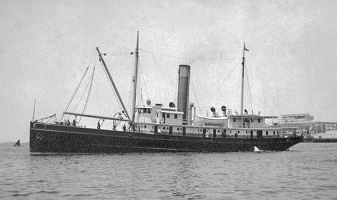 |
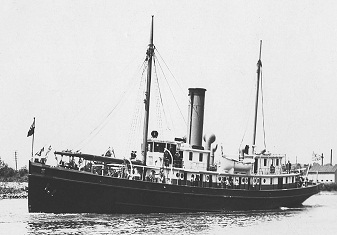 |
| Schofield | Ord |
 |
|
2. Like the Mills, Frank and Schofield we see that the Ord was constructed under the Office of the Quartermaster General and had a metal relief Quartermaster Corps Branch Insignia mounted on the bow. (Hagley Museum & Library - Pusey and Jones Corporation Collection) |
 |
|
3. The ship was named in honor of Major General Edward Otho Cresap Ord. Ord was a distinguished Civil War era Union commander who also conducted the first land surveys of Sacramento and Los Angeles, California. (National Archives and Records Administration) |
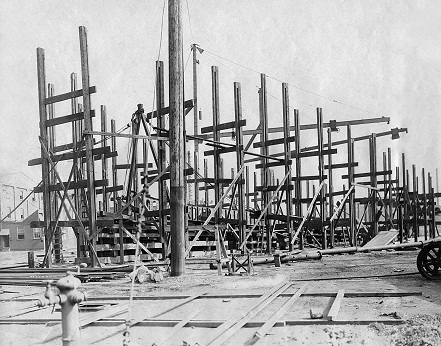 |
|
4. At the Pusey and Jones shipyard the Ord's hull was constructed using a complex system of scaffolds and wooden bracing. (Hagley Museum & Library - Pusey and Jones Corporation Collection) |
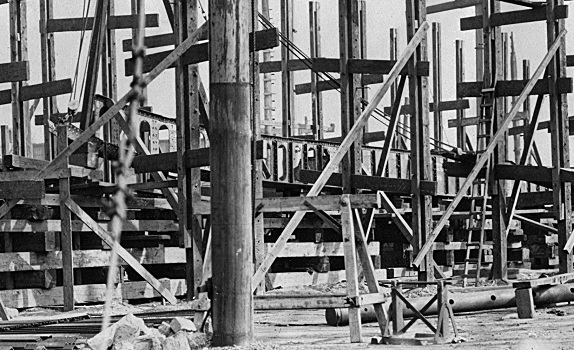 |
|
5. Here we can see the intricate geometry
involved in laying out the Ord's keel. |
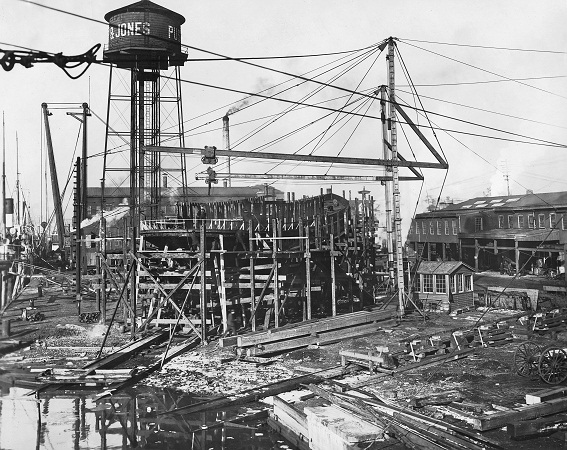 |
|
6. Large overhead booms, cranes, and gantries were used to position the steel plates of the Ord's hull and decking. (Hagley Museum & Library - Pusey and Jones Corporation Collection) |
 |
|
7. Upon closer examination we can see the
vertical steel plating of the main deck superstructure being assembled.
|
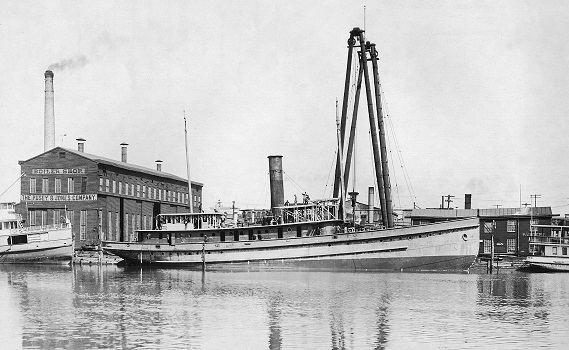 |
|
8. With major steelwork completed after
launching the Ord is moored next to an enormous lifting boom which
is used to complete the ship's superstructure and help with finishing
work. |
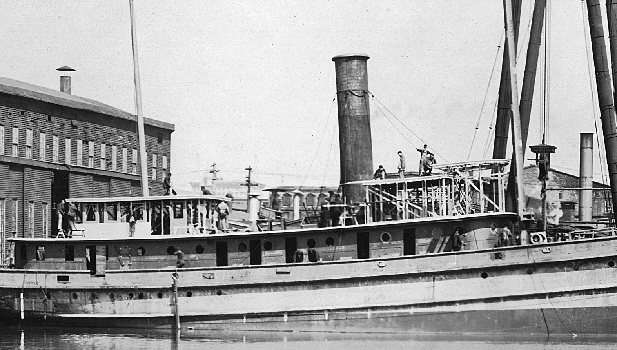 |
|
9. Here we see woodworkers framing up the wheelhouse and upper deck cabins. Just like the Mills, Frank, and Schofield the main deck cabins were constructed of steel plate while the upper deck cabins were made of pine. (Hagley Museum & Library - Pusey and Jones Corporation Collection) |
Once turned over to the military the General Ord began service in 1909 with the US Army Coast Artillery Corps until the War Department established the Army Mine Planter Service in 1918. The ship was first stationed out of Fort Hancock at Sandy Hook, New Jersey in defense of New York Harbor. During much of the ship's career communications cable work was completed under command of the US Army Signal Corp under the umbrella of the Army Mine Planter Service.
 |
|
10. The General Ord in service at Fort Wetherill, Rhode Island preparing to load sea mines, circa 1910. (Courtesy Andy Small from The Council on America's Past and Coast Defense Study Group) |
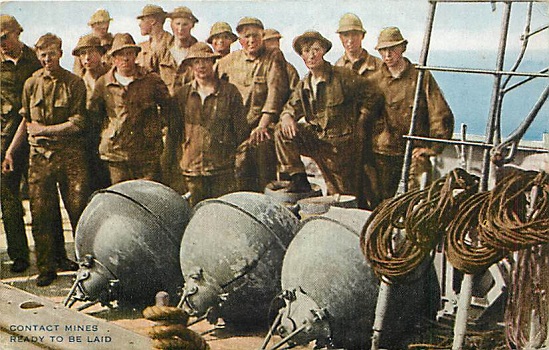 |
|
11. The caption on the back of this World War I era vintage postcard states, "Each one of these mines contains 100 pounds of gun cotton and when laid explodes immediately when anything comes in contact with it like the keel or side of a ship. Here you see a crew from the U.S. mine planter General E.O.S. Ord, after mine planting practice off Fort DuPont (Delaware). While not especially new, this type of marine mine has played an important part in the great European struggle, and has sent many ships to the bottom. These mines are laid in the entrance of harbors to prevent the entrance of hostile ships." (American Colortype Corp - Photo International Film Service) |
Like many of the Army's mine planters it appears the General Ord served in a number of different capacities depending on mission needs of the service. For example we know in the 1930s the Ord assisted at Sandy Hook with the Fort Hancock, New Jersey CMTC Camp and was used to tow artillery targets for off-shore for gunnery practice.
When WWII broke out on Dec 7th 1941 the USAMP Gen. Edward
O.C.S. Ord was again stationed out of Fort Hancock, New Jersey and assigned
under the Command of the Harbor Defenses of Sandy Hook and New York Harbor. In
November of 1942 the War Department assigned all Mine Planters a Battery Number.
The Ord became "The 5th Coast Artillery Mine Planter Battery" After 40
years at sea when WWII was over the General Ord was scrapped in 1948.
The 2nd General Samuel M. Mills
During WWII a new class of Army mine planters was constructed by
the Marietta Manufacturing Company of Point Pleasant, West Virginia in 1942-43.
Built for the U.S. Army Coast Artillery Corps Mine Planter Service, these 16
Camanche class ships which were 189' in length displaced 1320 tons and were
armed with one 40mm gun. In addition to mine laying operations many also did
general cable laying work and may have installed indicator loops to protect
harbors not covered by the Pequot. Compared to the 1909 generation of Army mine planters,
the Camanche class ships where much more sophisticated and also equipped to lay
cable. Most also saw service under
the US Navy.
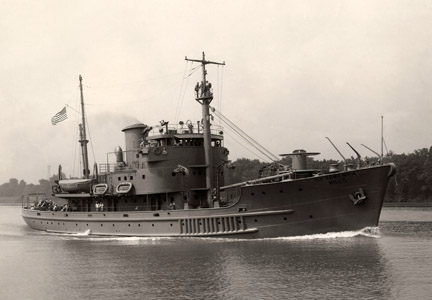 |
 |
|
1. The Army Mine
Planter the General Samuel M. Mills II steaming along the Ohio River.
August 11th 1942 Photo - Joyner Library, ECU. |
2. Commandant General Samuel M. Mills 1894. Special Collections, US Military Academy Library, West Point |
The General Samuel M. Mills (MP-4) was completed by Marietta in 1942 and
served under the Army through the 1950s. She was sold in 1960 and became the
Liberian Gran Canaria until scrapped in 1975.
 |
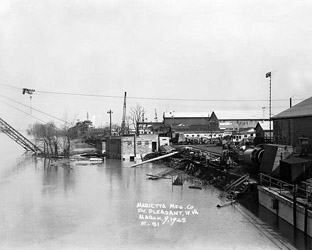 |
| 3. The Marietta Manufacturing Company of Point Pleasant, West Virginia. Photo - Joyner Library, ECU. | Marietta
shipbuilding operations along the bank of the Ohio River March 9th 1945. Photo - Joyner Library, ECU. |
The initials for the Marietta Manufacturing Company, M.M.C. also stood for its slogan, "Made Mechanically Correct." The company began in 1852 as a partnership known as W.F. Robertson & Sons Company of Beverly, Ohio. Robertson & Sons built stoves, capstans, boiler feed pumps, and other steamboat equipment. Located hundreds of miles from the nearest seaport, more than 70 ocean-going military vessels were built in Mason County West Virginia in the town of Point Pleasant by Marietta. Once launched off the riverbank into the Ohio River and completed, vessels from this shipyard had to navigate down the twisting Ohio into the Mississippi River and down to the Gulf of Mexico before heading into service in either the Atlantic or Pacific oceans.
During World War II, Marietta employed up to 2500 workers at
its peak period. In addition to the Army Mine planters the company constructed
four net tenders, fifty-three steam tugs for the U.S. Army, and two towboats for
the Defense Plant Corporation. Marietta had an great working relationship with
the U.S. government and in fact in 1944, the company received the Army-Navy "E"
award for exceptional service for war-time production.
 |
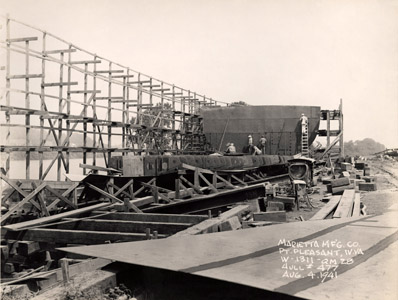 |
|
4. Here on July 16th 1941 we see workmen along the
bank of the Ohio River laying the ship's keel with steel plates against
wooden forms and bracing as they begin to fabricate hull number 477. Click to enlarge. Photo - Joyner Library, ECU. |
5. By August 4th we can see the double bottom hull
being fabricated as the first vertical bulkheads are installed. Click to enlarge. Photo - Joyner Library, ECU. |
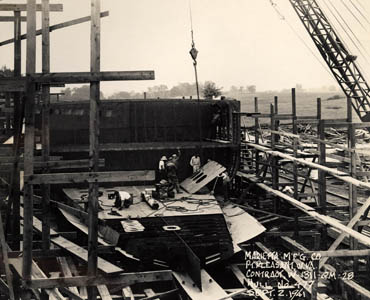 |
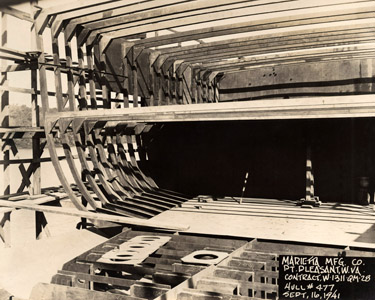 |
|
6.
On September 2nd with help of a crane
that moved along the river bank on rail tracks, we see a large steel
plate being positioned into what will become the lower hold. Click to enlarge. Photo - Joyner Library, ECU. |
7. The view from September 16th shows in cross section the steel framework for the lower deck and lower hold being framed up. Photo - Joyner Library, ECU. |
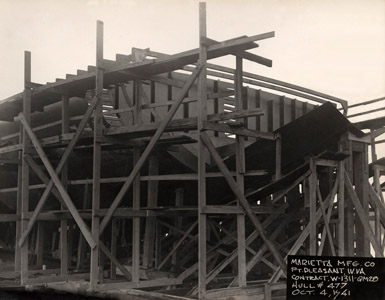 |
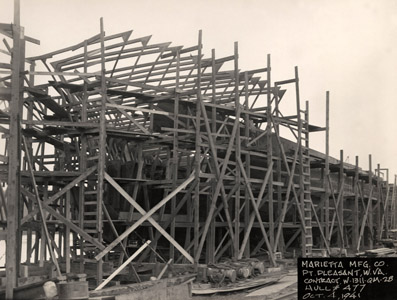 |
|
8. By October 4th we can see the stern being
fabricated using wooden forms braced with heavy duty scaffolding and
supports. Photo - Joyner Library, ECU. |
9. This port side view, also
from October 4th, shows the distinctive triangular shaped framing for the
ship's bow as we see progress being made on the installation of plates on
the hull below. Photo - Joyner Library, ECU. |
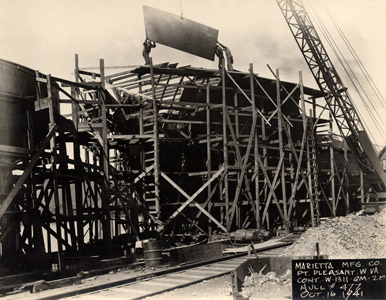 |
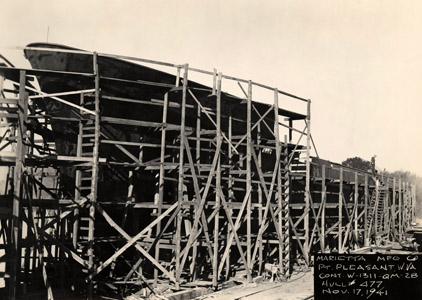 |
|
10. On October 16th we see the crane lowering a large
steel plate which will be installed on the bow framework. Photo - Joyner Library, ECU. |
11. By November 17th it appears that the hull is
completed behind the wooden scaffolding. Photo - Joyner Library, ECU. |
 |
 |
|
12. On launching day, February
3rd 1942, we see that the ship has been painted, exterior scaffolding has
been removed, and the Union Jack is flying proudly up at the bow. Click to enlarge. Photo - Joyner Library, ECU. |
13. This view of the stern was taken shortly before the Mills II
was launched off the river bank into the Ohio River. Photo - Joyner Library, ECU. |
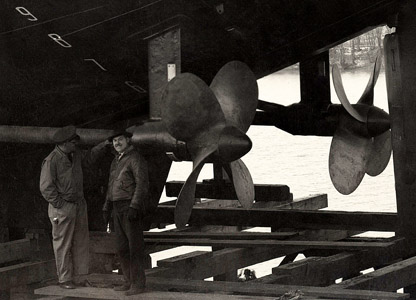 |
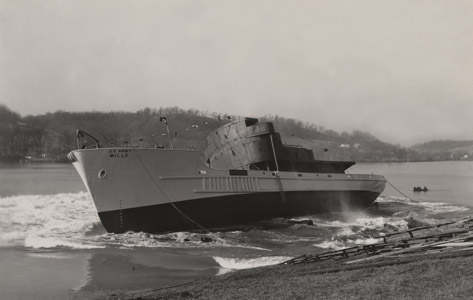 |
|
14. This close-up shows the ship's two massive propellers and
drive shafts getting a final inspection before being submerged for the first
time. Photo - Joyner Library, ECU. |
15. Coming off the riverbank, The Samuel M. Mills II slides off
the ways and into the Ohio River. Photo - Joyner Library, ECU. |
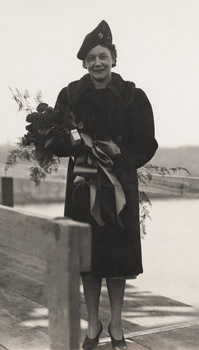 |
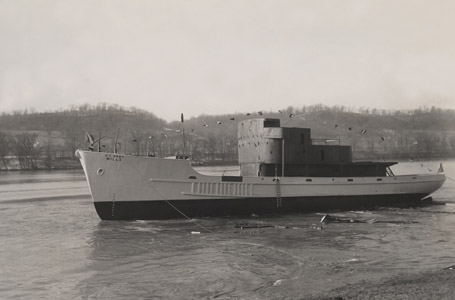 |
|
16. We haven't been able to learn her name, but the launching sponsor of
the Mills II is ready with flowers in hand on a cold February day in West
Virginia. |
17. After righting itself we see the ship afloat for the first
time. Much remains to be done to complete the ship's superstructure as well
as all interior work, masts and rigging. |
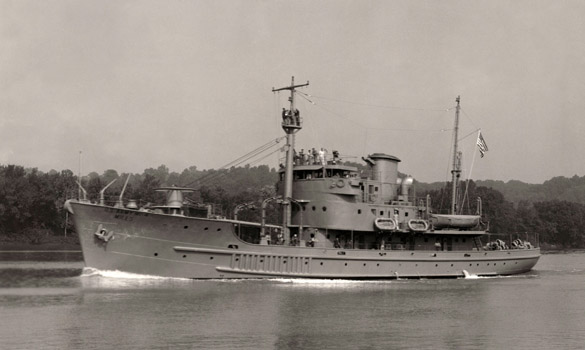 |
|
18. Here on August 11th 1942 we see the Samuel M. Mills II underway along the Ohio River before being turned over completely to the Army. Photo - Joyner Library, ECU. |
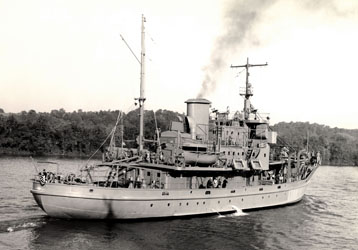 |
|
19. The Major General Wallace F. Randolph (MP-7) sister ship to the 1942 mine layer General Samuel M. Mills during sea trials. (Special Collections Department, J. Y. Joyner Library, East Carolina University, Greenville, North Carolina) Click To Enlarge. Photo - Joyner Library, ECU. |
The 2nd General Royal T. Frank
 |
|
1. The Army Mine Planter General Royal T.
Frank (USAMP-12) and crew docked at Fort Miles, Delaware. |
After the 1909 mine planter the General Royal
T. Frank was sunk in Hawaii by the Japanese after Pearl Harbor, a second
ship of the same name was built for the US Army in 1942 by the Marietta
Manufacturing Company of Point Pleasant, West Virginia. The Camanche Class Auxiliary Minelayer, USAMP Brigadier General Royal T. Frank
(MS 12) was activated on the 28th of November 1942 and transferred to the
Navy in 1944 and classified as ACM-11. She was reclassified several times and
re-named The Camanche but was never commissioned in the U.S. Navy. The ship
was sold in 1948. In 1961 she became the
Pilgrim out of Cape Cod, Massachusetts.
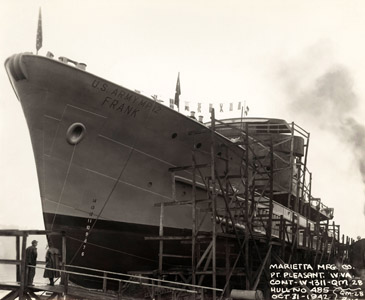 |
 |
|
2. A portside view of
the General Royal T. Frank II on launching day October 31st 1942.
Click to enlarge. Photo - Joyner Library, ECU. |
3. This stern
view gives us a glimpse of the ship's rudder and twin screws before
launching.
Click to enlarge. Photo - Joyner Library, ECU. |
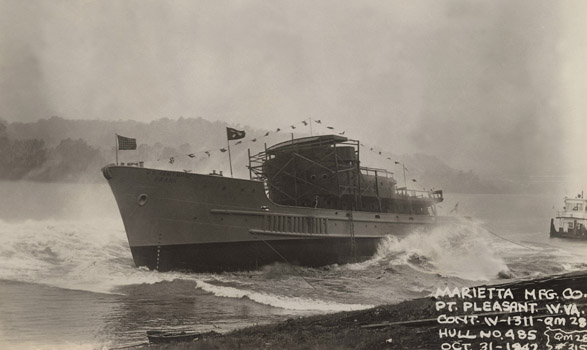 |
|
4.
Hull Number 485 is afloat for the first time as the second ship named to
honor the Civil War general slides off the bank and into the Ohio river. Click image to enlarge. Photo - Joyner Library, ECU. |
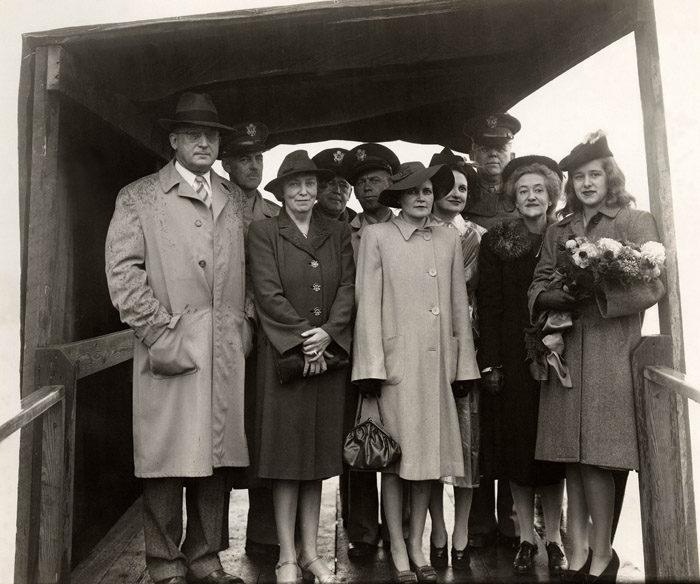 |
|
5. Here we see a group of dignitaries gathered for the launching ceremony. By the rain splattered overcoats it looks like it was a cold rainy day in West Virginia on October 31st, 1942. We see Army officers and representatives of Marietta Manufacturing with the ship's "Sponsor" on the right holding flowers. Photo - Joyner Library, ECU). For a fun look at ship launching and sponsors see "Ladies Who Launch" at: http://www.phillyseaport.org/web_exhibits/ladies_who_launch/ |
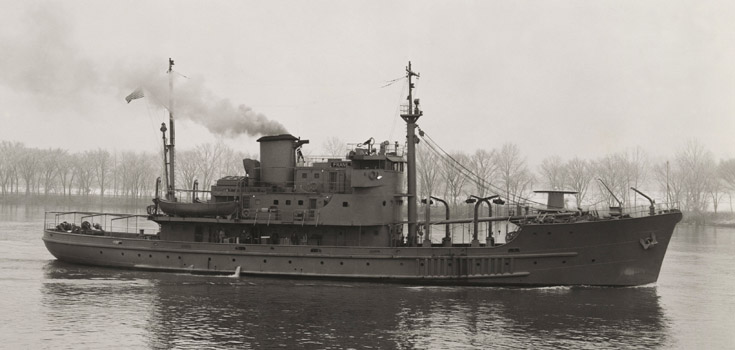 |
|
6.
After being fully fitted out, the Frank steams along the Ohio River on
January 8th 1943. |
 |
| 7. Sister ship to the General Frank, the mine planter Col. Horace F. Spurgin (MP-14) in 1950. Like the Pequot during WWII here we see the crew manually loading cable. (US Navy Photo)" |
The General William M. Graham
In 1917, nine years after the
Mills, Frank and Schofield were built, the
General William M. Graham was constructed at New York Shipbuilding under
contract #194 to what appears to be very similar specifications. The Graham's
keel was laid on April 2nd 1917 and she was constructed in shipway J. The ship
was launched on August 29th, 1917 and after complete outfitting and sea trials
was turned over to the War Department on January 3rd 1918. The ship was named to
honor the U.S. Army Brigadier General William Montrose Graham who fought during
the Civil War at Antietam and Gettysburg.
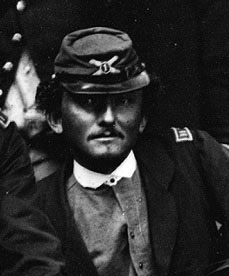 |
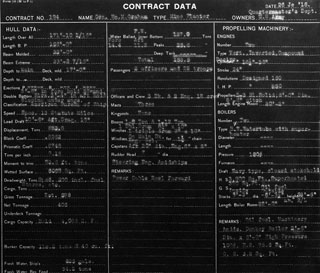 |
2. William M Graham September 1863 as an Army Captain.
Library of Congress) |
Contract for the construction of The
Graham. Independence Seaport Museum Archives). Click to enlarge. |
The Graham served as an Army
mine planter primarily on the Atlantic side of the Panama Canal Zone as part of
the harbor defense of Cristobal and, in fact, was renamed the USS Panama City
in 1947. The General William M. Graham fits into our Pequot
tale since this ship was apparently the first combined mine planter and cable
ship. She served at sea for 30 years until sold for scrap in Mobile, Alabama in
1948.
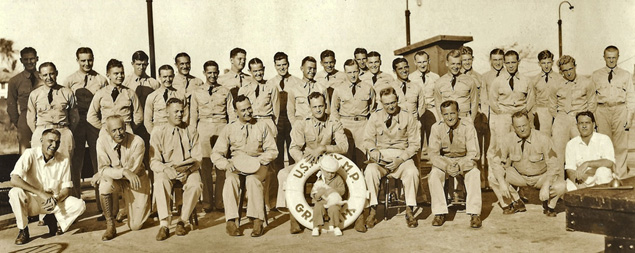 |
Crew of the General William M. Graham during WWII with mascot (Courtesy Bernadette MacInnes) |
After serving for 5 years in the Army's Coast Artillery Corps in the late 1930s, Stanley G. McInnes from Brooklyn, New York re-enlisted in March of 1942 and served in the Graham's engine room as an Oiler and Fireman during the Graham's WWII service in Panama.
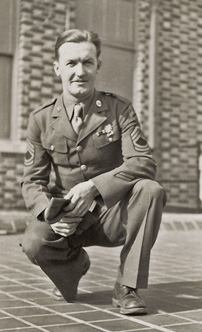 |
 |
Stanley McInnes during his service in Panama. (Courtesy Bernadette MacInnes) |
Behind him we see the World War I era S-class submarine the USS S-17 which also served to protect the Panama canal during the war years. (Courtesy Bernadette MacInnes) |
In these undated photos donated by his family we get a feeling for his service in the tropics of the Canal Zone, a long way from the chilly streets of Brooklyn.
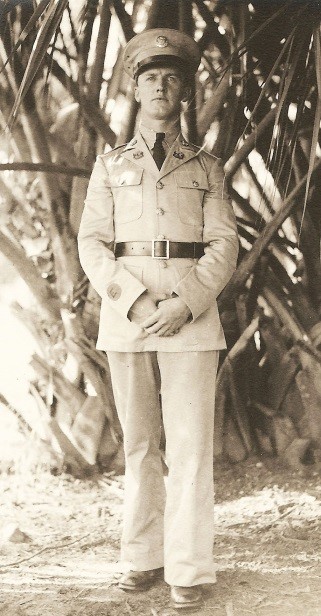 |
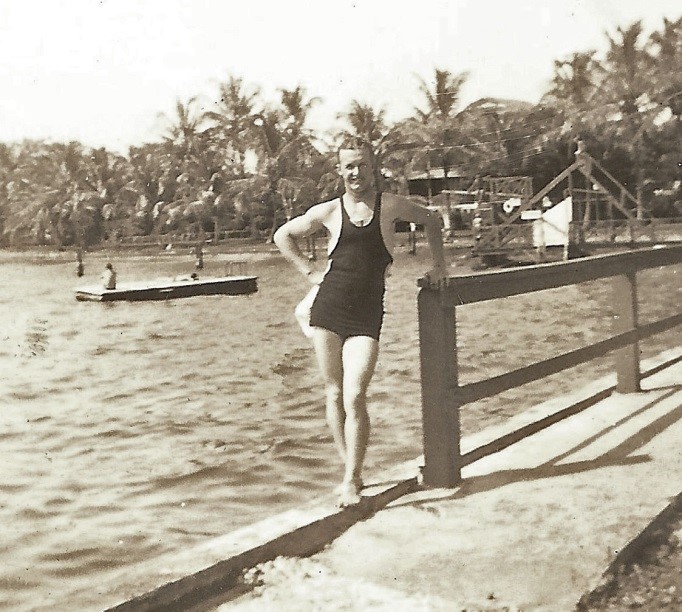 |
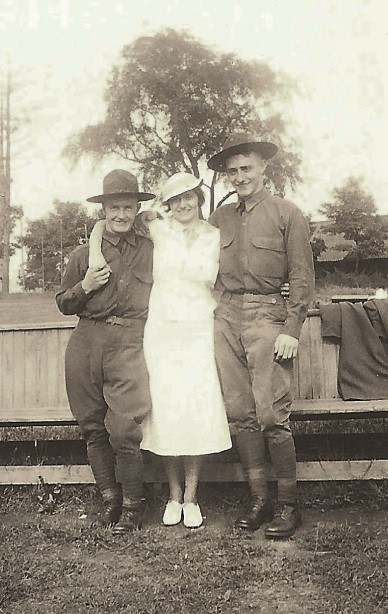 |
(Courtesy Bernadette MacInnes) |
The Joseph Henry
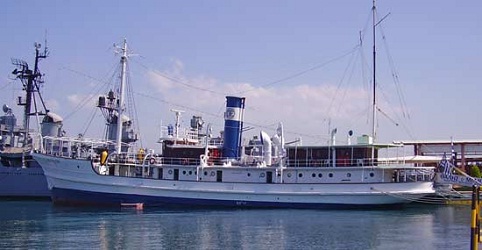 |
 |
|
(Photos by Aris Bilalis from Bill Burns' atlantic-cable.com) |
|
The Pequot's sister ship the CS Joseph Henry served under the US Army as both a cable ship and mine planter. Click a Photo above to follow the story of this ship from her construction in 1909 to her service today as a floating museum in Athens Greece.
Special Thanks to Matt Herbison at the Independence Seaport Museum and Dale Sauter at East Carolina University for locating these historic construction photos for us.
Special Thanks to Ramon Jackson.
For more information on the history of the Coast Artillery Corps and the
Army Mine Planter Service see:
http://patriot.net/~eastlnd2/army-amps.htm
Every effort has been made to trace and acknowledge
copyright. The authors would welcome any information from people who believe
their photos have been used without due credit.
Some photos have been retouched to remove imperfections but otherwise they
are true to the original.
FEEDBACK
If you have comments or queries specifically
about the Pequot or her Sister Ships, please contact
Chip Calamaio
chipaz@cox.net, 938 E. San Miguel Avenue, Phoenix, 85014, Arizona,
USA. (H) 602-279-4505.
Click here to go to the Pequot Main Page.
Click here to go to the Pequot Plans Page
Research and design: Chip Calamaio and Richard Walding





